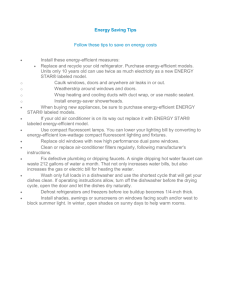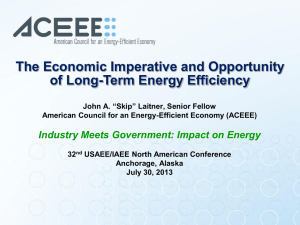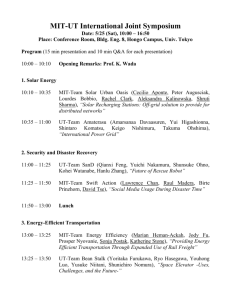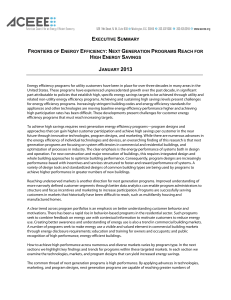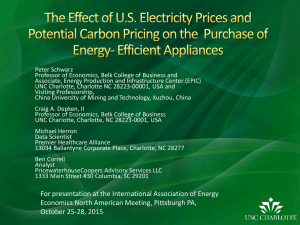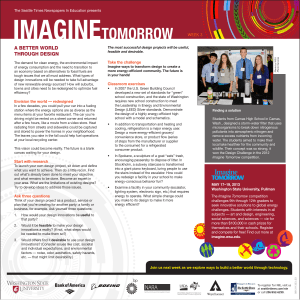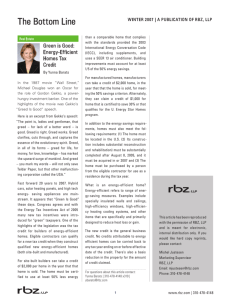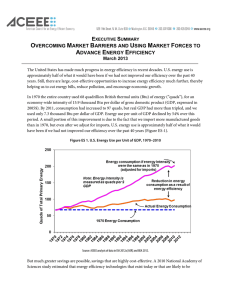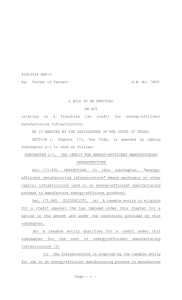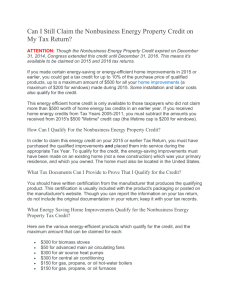America's Abundant, Untapped Energy Efficiency Resource
advertisement
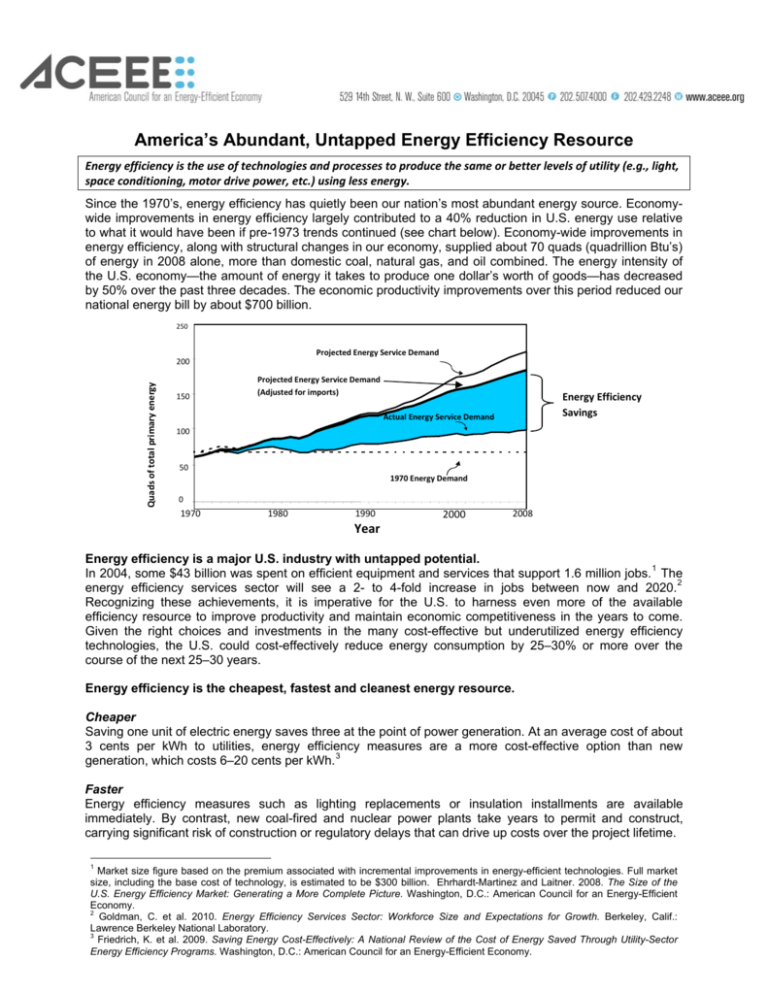
America’s Abundant, Untapped Energy Efficiency Resource Energy efficiency is the use of technologies and processes to produce the same or better levels of utility (e.g., light, space conditioning, motor drive power, etc.) using less energy. Since the 1970’s, energy efficiency has quietly been our nation’s most abundant energy source. Economywide improvements in energy efficiency largely contributed to a 40% reduction in U.S. energy use relative to what it would have been if pre-1973 trends continued (see chart below). Economy-wide improvements in energy efficiency, along with structural changes in our economy, supplied about 70 quads (quadrillion Btu’s) of energy in 2008 alone, more than domestic coal, natural gas, and oil combined. The energy intensity of the U.S. economy—the amount of energy it takes to produce one dollar’s worth of goods—has decreased by 50% over the past three decades. The economic productivity improvements over this period reduced our national energy bill by about $700 billion. 250 Projected Energy Service Demand Quads of total primary energy 200 Projected Energy Service Demand (Adjusted for imports) 150 Energy Efficiency Savings Actual Energy Service Demand 100 50 1970 Energy Demand 0 1970 1980 1990 Year 2000 2008 Energy efficiency is a major U.S. industry with untapped potential. In 2004, some $43 billion was spent on efficient equipment and services that support 1.6 million jobs. 1 The energy efficiency services sector will see a 2- to 4-fold increase in jobs between now and 2020. 2 Recognizing these achievements, it is imperative for the U.S. to harness even more of the available efficiency resource to improve productivity and maintain economic competitiveness in the years to come. Given the right choices and investments in the many cost-effective but underutilized energy efficiency technologies, the U.S. could cost-effectively reduce energy consumption by 25–30% or more over the course of the next 25–30 years. Energy efficiency is the cheapest, fastest and cleanest energy resource. Cheaper Saving one unit of electric energy saves three at the point of power generation. At an average cost of about 3 cents per kWh to utilities, energy efficiency measures are a more cost-effective option than new generation, which costs 6–20 cents per kWh. 3 Faster Energy efficiency measures such as lighting replacements or insulation installments are available immediately. By contrast, new coal-fired and nuclear power plants take years to permit and construct, carrying significant risk of construction or regulatory delays that can drive up costs over the project lifetime. 1 Market size figure based on the premium associated with incremental improvements in energy-efficient technologies. Full market size, including the base cost of technology, is estimated to be $300 billion. Ehrhardt-Martinez and Laitner. 2008. The Size of the U.S. Energy Efficiency Market: Generating a More Complete Picture. Washington, D.C.: American Council for an Energy-Efficient Economy. 2 Goldman, C. et al. 2010. Energy Efficiency Services Sector: Workforce Size and Expectations for Growth. Berkeley, Calif.: Lawrence Berkeley National Laboratory. 3 Friedrich, K. et al. 2009. Saving Energy Cost-Effectively: A National Review of the Cost of Energy Saved Through Utility-Sector Energy Efficiency Programs. Washington, D.C.: American Council for an Energy-Efficient Economy. America’s Abundant, Untapped Energy Efficiency Resource, © ACEEE Cleaner Energy efficiency measures limit energy consumption and the burning of fossil fuels (such as coal and natural gas) that in turn decrease air pollution and related respiratory illnesses. Where can we see the benefits of energy efficiency? Everywhere—each major sector of our economy invests in energy efficiency to reduce costs for consumers and businesses. Investments in products such as fuel-efficient vehicles, services like home energy improvements, or technologies and processes like combined heat and power (or cogeneration) in industrial facilities reduce waste. Money saved at the gas pump and from lower utility bills can be reinvested into local economies, creating jobs and reducing dependence on foreign oil. Our homes: Energy-efficient homes use substantially less energy than conventional homes. Residents of older homes may invest in energy improvements to tighten their “building envelope” by adding or replacing insulation and sealing leaky ducts, attics, and windows. Efficient HVAC (heating, ventilation, and cooling systems), water heating systems, and appliances can also significantly reduce energy bills. The payback to customers in comfort, air quality, and utility bill savings generally makes energy efficiency a smart consumer investment. New homes can be built “smart from the start” by installing energy-efficient equipment and appliances, and adhering to the latest building code or building performance standard such as ENERGY STAR® or LEED®. ACEEE has found that, on average, owners of existing homes can readily save 25–35% on their energy costs over the next 15 years by implementing cost-effective efficiency improvements. Our businesses: In the increasingly competitive global economy, U.S. businesses small and large must utilize energy efficiently to lead in the twenty-first century. Reducing energy waste—whether in commercial buildings, factories, or farms—is a critically important strategy for businesses aiming to lower overhead costs. Energy efficiency investments in lighting, HVAC systems, sensors, controls, motors, and other energy-saving technologies make businesses leaner, more competitive, and less vulnerable to volatile energy prices. The U.S. industrial sector, in particular, can benefit greatly from the implementation of combined heat and power (CHP) systems. CHP generates electricity and useful thermal energy in a single, integrated system. While the conventional method of producing usable heat and power separately has a typical combined efficiency of 45%, CHP systems can operate at levels as high as 85% efficiency. Our roads: The transportation sector keeps our economy moving, but we waste a lot of energy getting people and goods from place to place. High-efficiency vehicles use less fuel, reduce costs at the pump, and keep more money in the hands of consumers and businesses. Americans spend as much as 16% of their income on gasoline, leaving them vulnerable to spikes in oil prices. 4 Policies to improve vehicle efficiency and responsibly manage growth reduce financial risks faced by American citizens. Compact growth (or transit-oriented development) in communities makes it easier for people to travel between home and work without cars or by driving fewer miles. Improvements to public transportation systems can also help communities reduce their gasoline consumption and cost of commuting while promoting healthy lifestyles. The American Council for an Energy-Efficient Economy (ACEEE) is an independent, nonprofit organization dedicated to advancing energy efficiency as a means of promoting economic prosperity, energy security, and environmental protection. For more information, contact Suzanne Watson, Director of Policy (202-507-4006 or swatson@aceee.org) or visit www.aceee.org. 4 Kevin Quealy. “The Varying Impact of Gas Prices”. The New York Times. June 9, 2008. © American Council for an Energy-Efficient Economy, 529 14th Street, Suite 600, Washington, DC 20045 Phone: 202-507-4000. Fax: 202-429-2248. www.aceee.org. For additional information, email aceeeinfo@aceee.org 2
